Soap scum can be a real nuisance in your bathroom, leaving a cloudy film or white deposits on various surfaces. But worry not, as we have got you covered. In this detailed guide, we will provide you with simple steps on how to remove soap scum from different surfaces, including shower glass, doors, bathtubs, tiles, and even different materials like plastic tubs, shower walls, granite, marble, or natural stone. Follow these easy instructions to make your bathroom shine again!
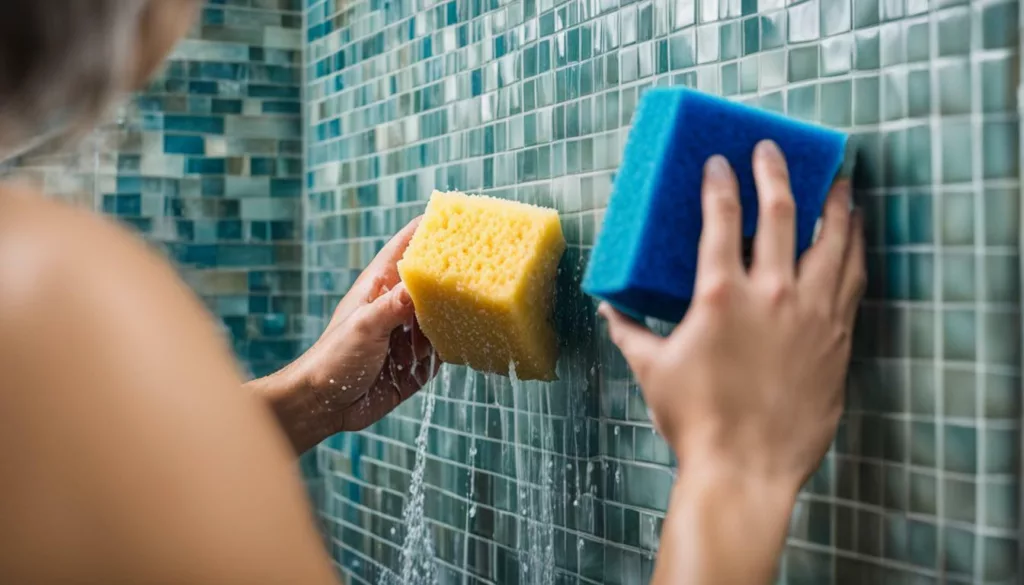
- Soap scum is a combination of soap residue, minerals from hard water, and body oils that accumulate on surfaces over time.
- Soap residue can appear as a cloudy film or white deposits and can be quite stubborn to remove.
- Effective soap film removal requires choosing the right cleaning products based on the surface you are cleaning.
- Prevention is key to avoiding soap scum buildup, so incorporate preventive measures into your cleaning routine.
- With the right techniques, you can effectively remove soap deposits and restore the beauty of your bathroom.
Introduction to Soap Scum
Before diving into how to remove soap scum, it’s important to understand what it is and why it forms. It is a combination of soap residue, minerals from hard water, and body oils that accumulate on surfaces over time. It often appears as a cloudy film or white deposit and can be quite stubborn to remove. It is particularly common in bathrooms, where soap and water are frequently used, and hard water is often present.
There are a variety of factors that contribute to the buildup of soap residue, including the type of soap and water used, as well as the frequency and effectiveness of cleaning. Additionally, certain surfaces, such as glass and natural stone, are more prone to soap film buildup than others.
Now that you have a better understanding of what it is and why it forms, let’s explore effective methods for removing it from various surfaces in your bathroom.

The shower is one of the most common areas where it builds up. If not removed in time, it can make your shower look dirty and uninviting. But don’t worry, we’ve got you covered! Follow these simple steps to effectively remove it from your shower:
- Remove excess water: Use a squeegee or a cloth to remove any excess water from the shower walls and surfaces.
- Mix a cleaning solution: In a spray bottle, mix equal parts of water and white vinegar or lemon juice. Alternatively, you can use a commercial soap residue remover.
- Spray the solution: Spray the cleaning solution liberally onto the shower walls and surfaces, paying extra attention to areas with visible scum buildup.
- Let it sit: Allow the cleaning solution to sit for 5-10 minutes to dissolve the scum and mineral buildup.
- Scrub: Use a soft-bristled brush or sponge to scrub gently in circular motions. Avoid using abrasive scrubbers like steel wool, as they can scratch the surface of your shower and cause permanent damage.
- Rinse: Rinse the shower walls and surfaces thoroughly with water, making sure to remove all the cleaning solution residue.
- Dry: Use a clean cloth or squeegee to dry the shower walls and surfaces. This will prevent water spots and mineral buildup from developing.
Repeat this process once a week to prevent soap scum buildup in your shower. Don’t forget to keep your shower well-ventilated and remove any excess water after use to prevent mold growth.
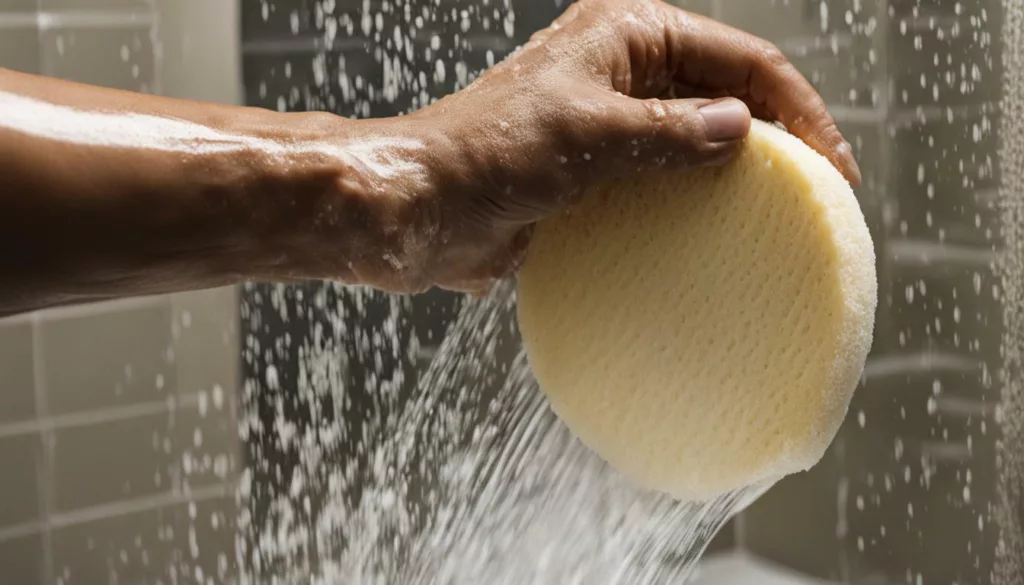
a). Remove From Glass Doors
If you have glass shower doors, you know how frustrating it can be to remove its buildup. Luckily, there are several effective methods for removing scum from glass shower doors.
One of the easiest methods is using a solution of equal parts water and white vinegar. Simply mix the solution in a spray bottle and apply it to the glass surface. Let it sit for a few minutes, then use a non-abrasive scrubber to gently scrub away the soap scum. Rinse the surface with water and wipe it dry with a clean cloth.
If the vinegar solution doesn’t work, you can try using baking soda and water. Create a paste of baking soda and water, then apply it to the glass surface using a sponge. Let it sit for 10-15 minutes, then scrub it away with a non-abrasive scrubber. Rinse the surface with water and wipe it dry with a clean cloth.
If you prefer to use commercial products, look for a cleaner specifically designed for removing soap residue from glass surfaces. Be sure to follow the instructions on the label carefully.
It’s important to avoid using abrasive cleaners or tools on glass shower doors, as they can scratch and damage the surface. Additionally, avoid using acidic cleaners like lemon or vinegar on natural stone surfaces like marble or granite, as they can etch the surface and cause permanent damage.

With these effective methods, you can say goodbye to unsightly scum stains on your glass shower doors and enjoy a sparkling clean bathroom.
b). Removing Soap Scum from Bathtub
If you have a bathtub, you know that it can be a real challenge to keep it clean and free from soap layers or film buildup. It can make your bathtub look dingy and unclean, but with the right techniques, you can restore its shine and make it look as good as new.
Here’s how to remove it from your bathtub:
- Clean with vinegar and baking soda: Mix equal parts vinegar and baking soda to form a paste, and apply it to the affected areas. Let it sit for about 15 minutes, then scrub with a non-scratch sponge or brush. Rinse with water and dry with a clean towel.
- Use a commercial scum remover: You can find a variety of scum removers at your local hardware or home improvement store. Follow the instructions on the label carefully and wear gloves and safety goggles to protect yourself from the chemicals.
- Try a natural scum remover: Mix equal parts vinegar and water in a spray bottle, spray the affected areas, and let it sit for a few minutes. Scrub with a non-scratch sponge or brush, rinse with water and dry with a clean towel.
Whichever method you choose, make sure to test it on a small, inconspicuous area first to ensure it doesn’t damage your bathtub’s surface. Also, avoid using abrasive sponges or brushes that can scratch the surface.
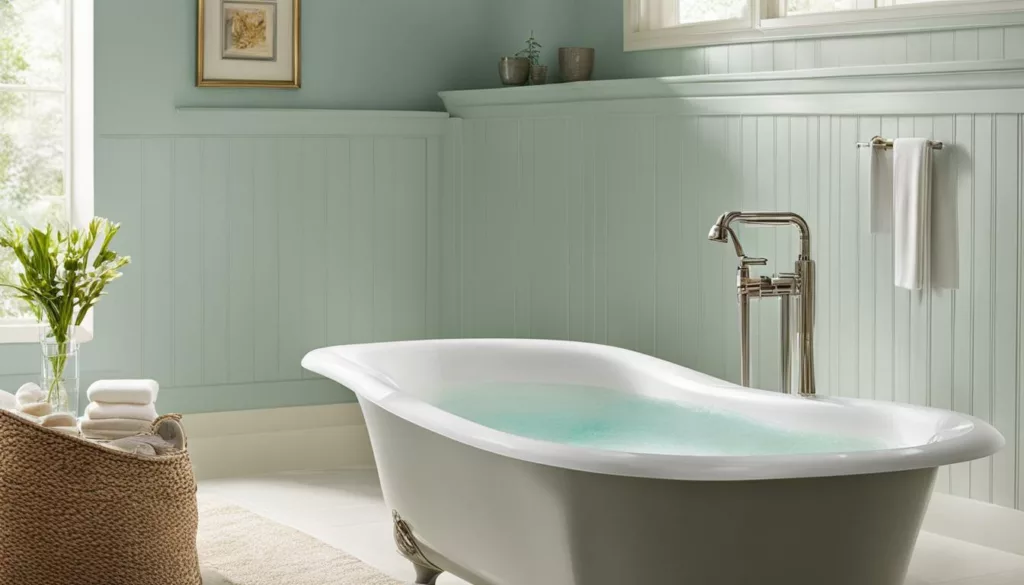
Following these simple steps will help you remove the scum from your bathtub, leaving it looking clean and shiny. Remember to clean your bathtub regularly to prevent its buildup.
c). Removing Soap Scum from Shower Glass
Soap scum on shower glass can be particularly stubborn and unsightly, making your shower look dirty and uninviting. Fortunately, there are several effective methods and products that can help you remove it from your shower glass.
One of the simplest and most effective ways to remove it from the shower glass is to use white vinegar. Simply mix equal parts white vinegar and water in a spray bottle, shake well, and spray the solution directly onto the affected areas of your shower glass. Let the solution sit for a few minutes to dissolve the scum, then wipe clean with a microfiber cloth or a squeegee. Repeat the process as needed until it is completely removed.
If the white vinegar solution doesn’t work or you prefer a store-bought cleaner, look for a cleaner specifically designed for removing it from the shower glass. These cleaners typically contain ingredients like citric acid or ammonium hydroxide that can dissolve it with minimal effort.
When using any cleaning product on shower glass, it’s important to test it first on a small, inconspicuous area to ensure it doesn’t damage or discolor the glass. Always follow the manufacturer’s instructions and use gloves or protective eyewear if necessary.
| Pros | Cons |
|---|---|
| – White vinegar is an affordable and eco-friendly solution for removing soap scum from shower glass. – Store-bought cleaners specifically designed for scum removal can be effective and convenient to use. |
– Using the wrong cleaning product or technique can damage or scratch your shower glass. – Removing tough or old soap residue from shower glass may require several applications or professional cleaning. |
By following these tips and techniques, you can effectively remove it from your shower glass and restore its clarity and shine. Don’t let it ruin your shower experience – take action today and enjoy a clean and beautiful bathroom.

d). Removing Soap Scum from Plastic Tub
Its buildup on a plastic tub can be a real eyesore and can make your bathroom look unclean. But, fear not! With the right products and techniques, you can easily remove it from your plastic tub without causing any damage.
Begin by pouring a cup of white vinegar into a spray bottle and spraying the affected areas of your plastic tub. Allow the vinegar to sit for a few minutes to loosen the soap scum.
Next, take a nylon brush with soft bristles and gently scrub the surface of the plastic tub to remove it. Be careful not to apply too much pressure, as this can cause scratches or damage to the tub.
Rinse the tub thoroughly with warm water to remove any remaining vinegar or scum residue. For tougher stains, you can also use a commercial cleaner specifically designed for soap scum removal on plastic surfaces.
Remember, it’s important to choose a non-abrasive cleaner for a plastic tub as harsh chemicals or rough scrubbing can cause damage and scratches.
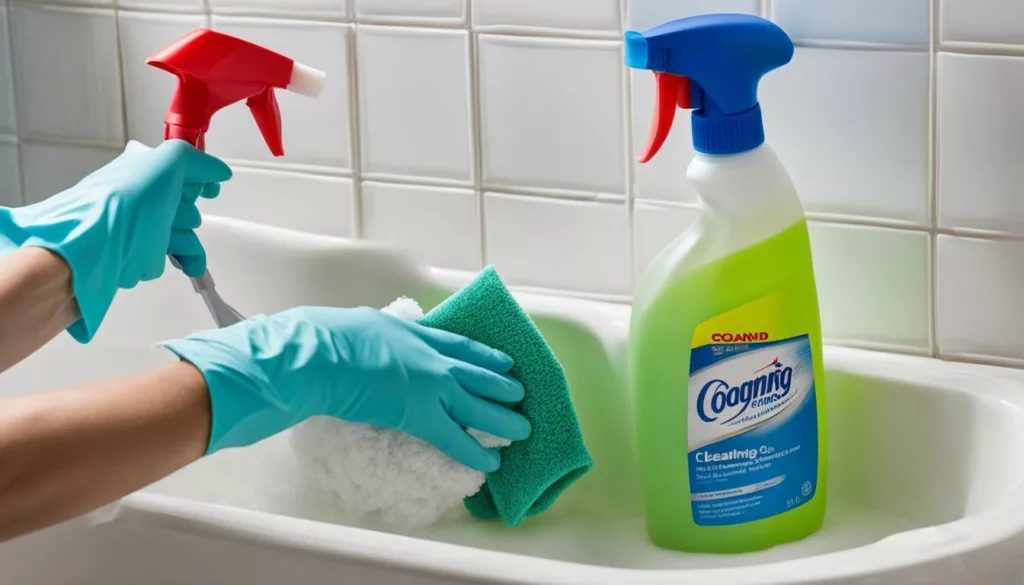
e). Removing Soap Scum From Shower Walls
Soap scum can accumulate on shower walls, making them look dirty and uninviting. Luckily, there are several effective techniques and products you can use to remove scum and restore your shower walls to their former glory.
Before you begin: Make sure to test any cleaning product on a small, inconspicuous area of your shower walls first to ensure it doesn’t cause any damage.
Method 1: Vinegar and Baking Soda
| Materials: | White vinegar, baking soda, spray bottle, scrub brush or sponge |
|---|---|
| Steps: |
|
Method 2: Commercial Cleaners
| Materials: | Commercial soap scum remover, scrub brush, or sponge |
|---|---|
| Steps: |
|
Method 3: Preventive Measures
Prevent soap film from accumulating on your shower walls by regularly cleaning them after each use. A quick wipe-down with a squeegee or towel can go a long way in preventing soap deposit buildup.
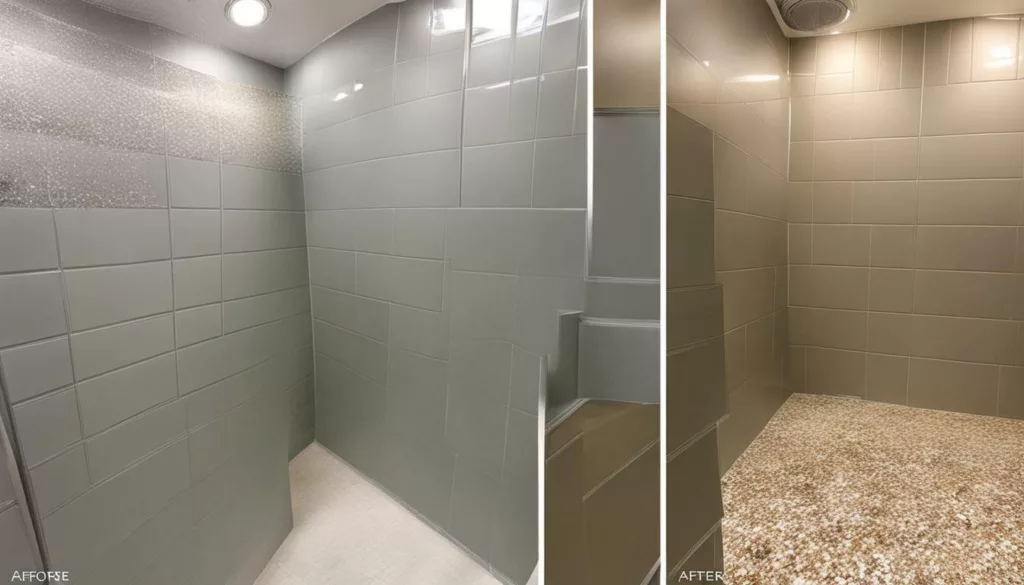
f). Removing Soap Scum from Tile
Tiles are a popular choice for bathrooms due to their durability and aesthetic appeal. However, they are also prone to soap film buildup, which can make them look dull and unsightly. Follow these easy steps to effectively remove it from your tiles:
- Gather your supplies. You will need a few items to get started, including a spray bottle, white vinegar, baking soda, a sponge or scrub brush, and a clean towel.
- Create a cleaning solution. Fill the spray bottle with equal parts white vinegar and water. If the soap deposit buildup is particularly stubborn, you can add a tablespoon of baking soda to the mixture.
- Spray the solution onto the tiles. Be sure to fully saturate the affected areas with the cleaning solution.
- Let the solution sit. Allow the cleaning solution to sit on the tiles for at least 10 minutes. This will give it time to penetrate and break down the soap deposit.
- Scrub the tiles. Using a sponge or scrub brush, gently scrub the tiles in a circular motion. Focus on the areas with the most buildup, but be careful not to damage the grout.
- Rinse the tiles. Rinse the tiles with water to remove any remaining scum and cleaning solution.
- Dry the tiles. Use a clean towel to dry the tiles and prevent any water spots or streaks.
Remember to clean your tiles regularly to prevent soap film buildup. If you have particularly hard water, you may want to consider installing a water softener to reduce mineral buildup on your tiles and other bathroom surfaces.
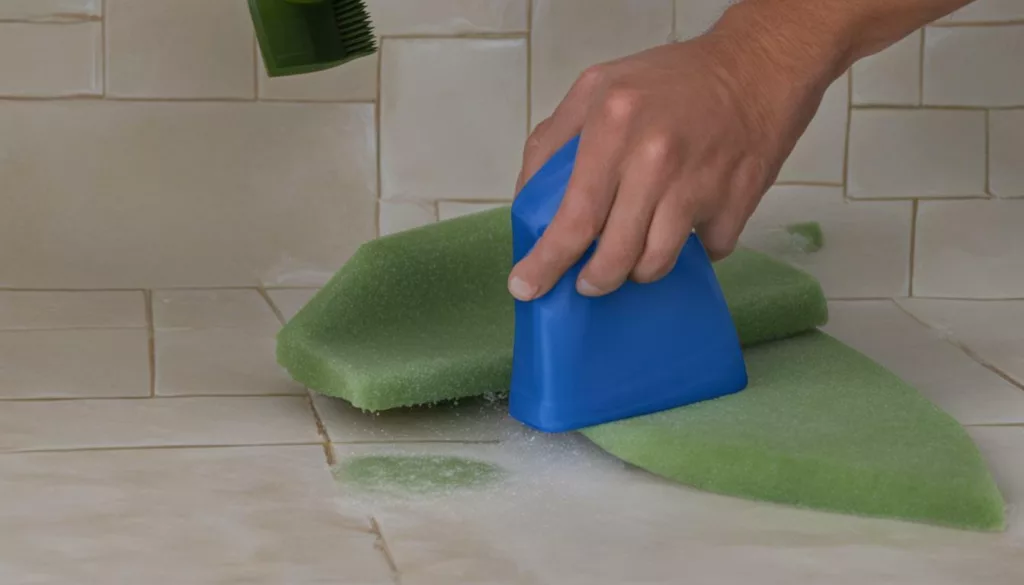
g). Removing Soap Scum from Granite
Granite surfaces are both beautiful and durable, but they require special care when it comes to removing soap deposits. Avoid using acidic or abrasive cleaners that can etch or scratch your granite. Follow these steps to safely remove scum deposits from granite surfaces:
- Create a cleaning solution by mixing warm water and a gentle, pH-neutral dish soap.
- Dampen a soft cloth or sponge in the cleaning solution.
- Gently rub the cloth or sponge over the deposited scum on the granite surface, being careful not to apply too much pressure.
- Rinse the sponge or cloth in clean water and wipe the granite surface to remove any soap residue.
- Dry the surface with a clean, dry cloth or towel to prevent water spots.
If the soap deposits are particularly stubborn, you can try using a granite-safe cleaner or a mixture of baking soda and water to create a paste. Apply the paste to the soap deposits and let it sit for a few minutes before wiping it away with a soft cloth or sponge.
Remember to avoid using vinegar, lemon juice, or any other acidic or abrasive cleaners on your granite surfaces, as they can cause damage. With a bit of gentle care, you can safely remove soap deposits from your granite countertops and keep them looking like new.
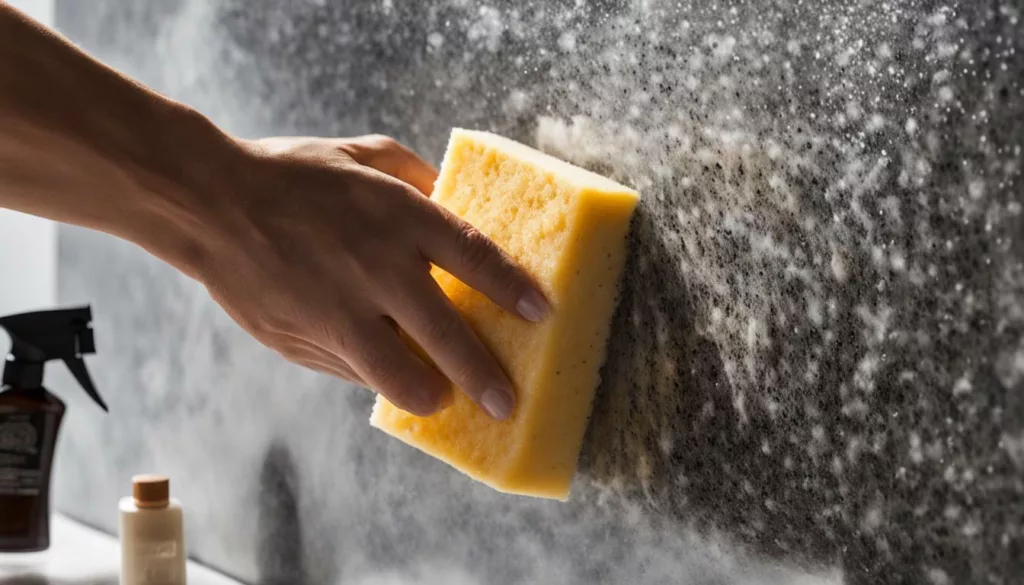
h). Removing Soap Scum from Marble
Marble is a beautiful and luxurious material often used for bathroom surfaces, but it requires special care when it comes to removing soap deposits. Because marble is porous and susceptible to etching, it is important to avoid using acidic solutions that can cause damage. Here are some simple steps to safely remove soap deposits from marble:
- Mix a gentle cleaning solution by combining warm water and a mild pH-neutral cleaner. Avoid using vinegar, lemon juice, or other acidic substances that can damage the marble surface.
- Dip a soft sponge or cloth into the cleaning solution and wipe the marble surface gently, focusing on areas with soap scum buildup. Do not scrub too hard as this can scratch or etch the marble.
- Rinse the marble surface with clean water and dry it with a soft towel or cloth.
- If the soap deposit is still visible, repeat the process or use a specialized marble cleaner specifically designed for soap scum removal.
Remember that prevention is key to avoiding soap deposit buildup on marble surfaces. Avoid using harsh soaps and cleaners, and always wipe down the marble surface after use to prevent soap and water from sitting on the surface. Regular cleaning and maintenance can help keep marble surfaces looking beautiful and free from soap deposit buildup.
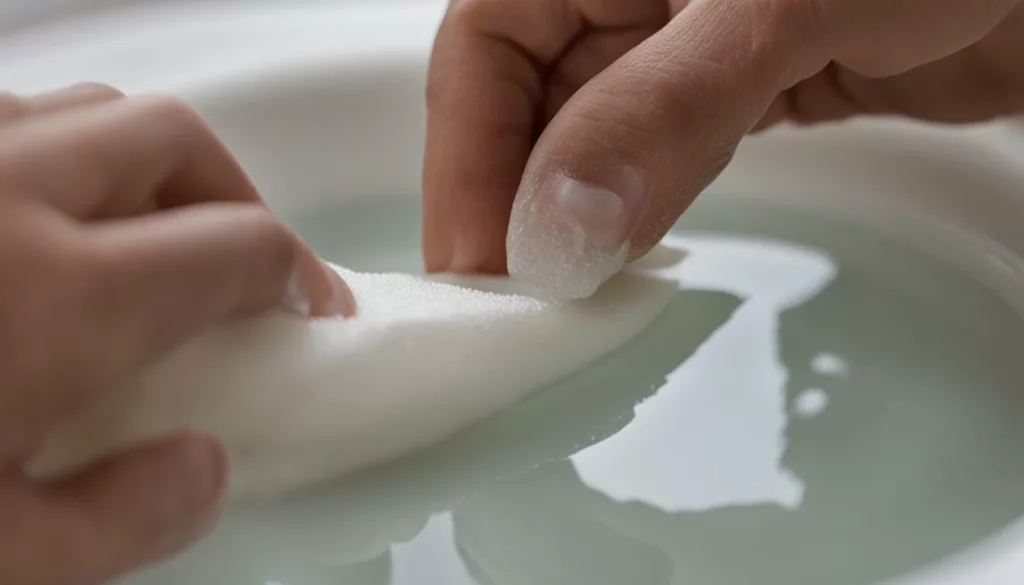
i). Removing Soap Scum from Natural Stone
Natural stone surfaces like travertine, limestone, or marble require special care when it comes to removing soap deposits. Different natural stones have varying degrees of porosity, which can affect how they react to cleaning agents. Here are some tips on how to safely remove soap deposits from natural stone surfaces:
- Wipe down the surface with a soft cloth or sponge dipped in warm water and a mild pH-neutral soap. Avoid using acidic or alkaline cleaners, such as vinegar or bleach, as they can etch the surface of the stone.
- If the soap deposits are stubborn, try using a specialized natural stone cleaner that is formulated to dissolve soap deposits without causing damage. Make sure to follow the manufacturer’s instructions and test the cleaner on a small, inconspicuous area first.
- For particularly tough soap film stains, you can try making a paste using baking soda and water. Apply the paste to the affected area and let it sit for a few minutes before gently scrubbing with a soft-bristled brush or sponge. Rinse thoroughly with water.
- After cleaning, make sure to dry the natural stone surface thoroughly with a clean, dry cloth. Natural stone is porous and can absorb moisture, which can cause stains or discoloration over time.
By following these tips, you can safely and effectively remove soap deposits from natural stone surfaces without causing damage. Remember to clean and maintain your natural stone surfaces regularly to prevent soap deposit buildup.
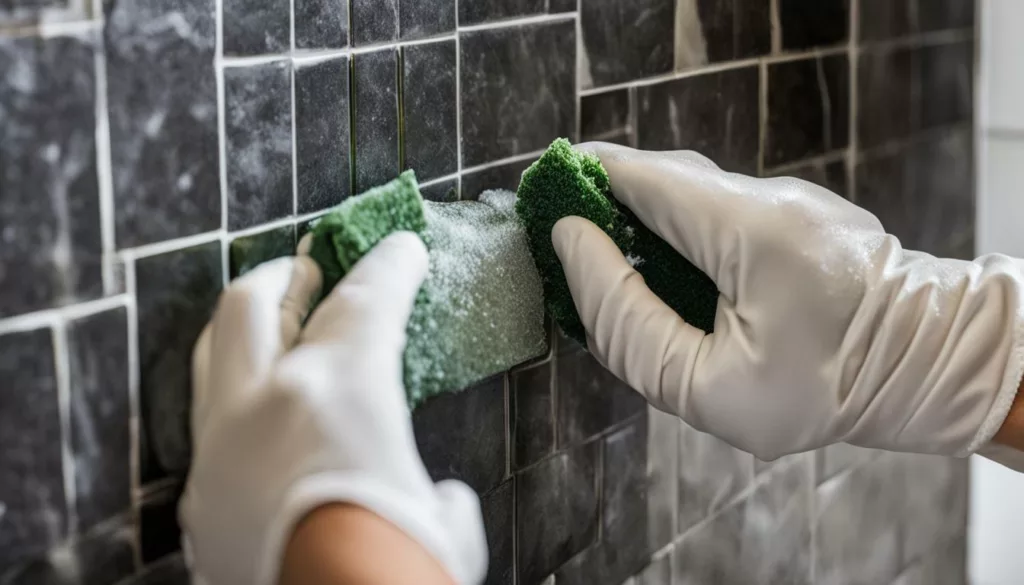
Now that you know how to effectively remove deposits from various surfaces in your bathroom, it’s important to take preventative measures to avoid buildup in the first place. These simple tips will help you maintain a clean and soap-deposits-free bathroom:
- Use liquid soap: Bar soap leaves behind more residue than liquid soap, contributing to soap scum buildup.
- Squeegee shower walls and doors: After each shower, use a squeegee to remove excess water and soap residue from your shower walls and doors. This will prevent soap scum from accumulating over time.
- Wipe down surfaces: Regularly wipe down your shower, bathtub, and sink surfaces with a soft cloth or sponge to prevent soap scum from building up.
- Clean your bathroom regularly: Set a weekly cleaning schedule that includes scrubbing your bathroom surfaces thoroughly with soap scum removing products to prevent buildup.
- Install a water softener: Hard water minerals contribute to soap scum buildup. Installing a water softener will help prevent this issue.
By following these tips, you can significantly reduce soap scum buildup in your bathroom and keep it looking clean and fresh.

Choosing the right cleaning products is crucial for effectively removing soap scum from your bathroom surfaces. Not all cleaners are created equal, and some may be harmful to certain materials. Here are some tips on how to choose the right cleaning products for soap deposit removal:
- Consider the surface: Different surfaces require different cleaning agents. For instance, abrasive cleaners like baking soda or harsh chemicals may scratch or damage delicate surfaces such as marble or granite. Be sure to select the appropriate product for the surface you are cleaning.
- Read the label: Take the time to read the labels of cleaning products before purchasing them. Look for products that specifically mention soap scum removal or are suitable for the surface you are cleaning.
- Avoid harsh chemicals: Harsh chemicals like bleach or ammonia may be effective in removing soap scum, but they can also be harmful to your health and the environment. Consider using natural or non-toxic alternatives to harsh chemicals.
- Try DIY cleaners: You can make your own cleaning solutions using common household ingredients like vinegar, baking soda, and lemon. These DIY cleaners are effective and safe for use on most bathroom surfaces.
- Test a small area: Before using any new cleaning product, be sure to test it on a small, inconspicuous area first to ensure it doesn’t damage or discolor the surface.
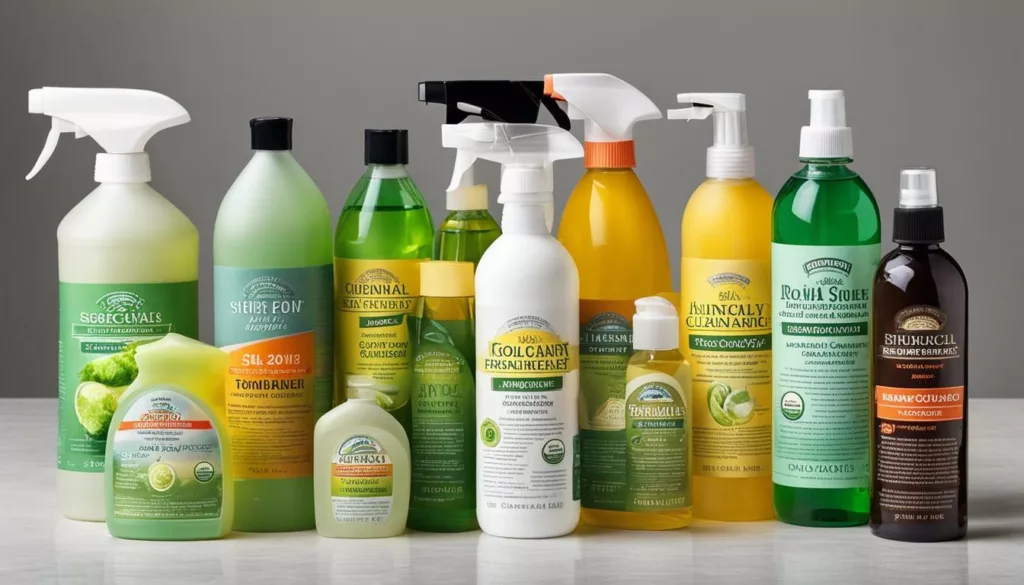
By following these tips, you can choose the right cleaning products to effectively remove soap deposits without damaging your bathroom surfaces. Always remember to read labels, avoid harsh chemicals, and test a small area before using a new product.
Conclusion
You have now learned how to effectively remove soap deposits from various surfaces in your bathroom. By following the simple steps outlined in this guide, you can enjoy a clean and sparkling bathroom free from unsightly soap deposit buildup. Remember to regularly clean and maintain your bathroom to prevent soap scum from returning.
Takeaways
- Soap deposits are a combination of soap residue, minerals from hard water, and body oils that accumulate on surfaces over time.
- There are different methods and products to remove soap deposits from various surfaces, including shower glass, doors, bathtubs, tiles, and different types of materials like plastic tubs, shower walls, granite, marble, and natural stone.
- Choose the appropriate cleaning products based on the surface you are cleaning for optimal results.
- Prevention is key to minimizing soap deposit buildup. Incorporate preventive measures into your cleaning routine.
Happy Learning
Also, Read,
How To Unclog A Kitchen Sink Effectively
12 Easy Steps to Unclog a Toilet
Stylish Frameless Shower Doors
Euro Pillow – Upgrade Your Sleep
FAQ
What is soap scum?
It is a combination of soap residue, minerals from hard water, and body oils that accumulate on surfaces over time. It can appear as a cloudy film or white deposits.
How do I remove soap scum from my shower?
To remove soap deposits from your shower, you can use a mixture of vinegar and water, a scrub brush, and a non-abrasive cleaner. Apply the vinegar and water mixture, scrub the surfaces with a brush, and then rinse with water. Finish by applying a non-abrasive cleaner and wiping dry.
How do I remove soap deposits from glass shower doors?
Soap deposits on glass shower doors can be removed using a mixture of baking soda and water, a scrub brush, and a glass cleaner. Mix the baking soda and water to create a paste, apply it to the doors, scrub with a brush, rinse with water, and then clean with a glass cleaner.
Can I remove soap deposits from a plastic tub?
Yes, you can remove soap deposits from a plastic tub. Use a mixture of vinegar and water, a scrub brush or sponge, and a non-abrasive cleaner. Apply the vinegar and water mixture, scrub the surfaces, rinse with water, and then clean with a non-abrasive cleaner.
What can I use to remove soap deposits from the tile?
To remove soap deposits from the tile, you can use a mixture of baking soda and water, a scrub brush, and a tile cleaner. Create a paste with the baking soda and water, apply it to the tile, scrub with a brush, rinse with water, and then clean with a tile cleaner.
How do I prevent soap deposit buildup?
To prevent soap deposit buildup, you can regularly clean and dry your bathroom surfaces, use liquid soap instead of bar soap, and consider using a water softener or installing a water filter to reduce the minerals in your water.



